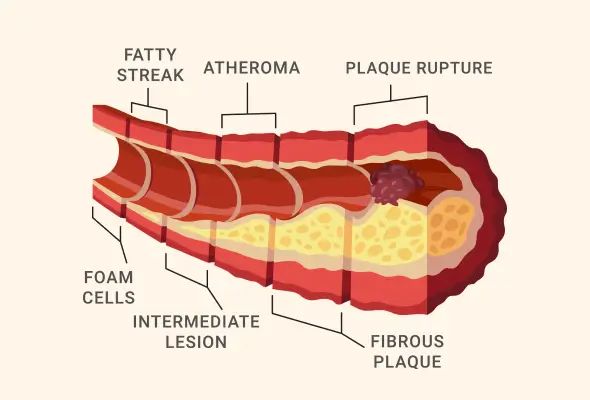-
Doctors
-
Specialities & Treatments
Centre of Excellence
Specialties
Treatments and Procedures
Hospitals & Directions HyderabadCARE Hospitals, Banjara Hills CARE Outpatient Centre, Banjara Hills CARE Hospitals, HITEC City CARE Hospitals, Nampally Gurunanak CARE Hospitals, Musheerabad CARE Hospitals Outpatient Centre, HITEC City CARE Hospitals, Malakpet
HyderabadCARE Hospitals, Banjara Hills CARE Outpatient Centre, Banjara Hills CARE Hospitals, HITEC City CARE Hospitals, Nampally Gurunanak CARE Hospitals, Musheerabad CARE Hospitals Outpatient Centre, HITEC City CARE Hospitals, Malakpet Raipur
Raipur
 Bhubaneswar
Bhubaneswar Visakhapatnam
Visakhapatnam
 Nagpur
Nagpur
 Indore
Indore
 Chh. Sambhajinagar
Chh. SambhajinagarClinics & Medical Centers
Book an AppointmentContact Us
Online Lab Reports
Book an Appointment
Consult Super-Specialist Doctors at CARE Hospitals

Atherosclerosis
Symptom, Causes, Diagnosis and Treatment
Atherosclerosis
Atherosclerosis is a silent yet serious condition that affects millions worldwide. We often hear about it in medical discussions, but what exactly is atherosclerosis? It's a disease that causes a build-up of plaque in the arteries, resulting in a narrowing and hardening of these vital blood vessels. This process can have a significant impact on health, potentially causing heart disease, strokes, and other cardiovascular problems.
In this article, we'll dive into the ins and outs of atherosclerosis and explore what causes this condition, the signs and symptoms of atherosclerosis, and the risk factors that make some people more prone to developing it.

What is Atherosclerosis?
Atherosclerosis is a condition that has an impact on the arteries. It happens when a sticky substance called plaque builds up inside the artery walls. This plaque comprises fat, cholesterol, calcium, and other substances found in the blood. As the plaque accumulates, it causes the arteries to become thicker and harder, narrowing the space for blood to flow through.
You can think of atherosclerosis as a gradual process that can start as early as childhood and get worse over time. It's often called "hardening of the arteries" because it makes the artery walls less flexible. This narrowing can decrease the amount of oxygen-rich blood reaching the organs and tissues.
Atherosclerosis can affect arteries throughout the body, including those in the heart, brain, arms, legs, and kidneys. Atherosclerosis can lead to different health problems depending on which arteries are affected.
Causes of Atherosclerosis
We're not entirely sure what causes atherosclerosis, but we know it's a gradual process that can start as early as the teenage years. The condition begins with damage to the inner layer of an artery. This damage can have an impact on the blood vessels due to various factors, including high blood pressure, high cholesterol, smoking, diabetes, and obesity.
Once the artery wall is damaged, blood cells and other substances start to build up at the injury site. Over time, fats, cholesterol, and other materials collect on the artery walls, forming plaque. This plaque narrows the arteries, diminishing blood flow. The plaque can sometimes rupture, leading to blood clot formation.
Inflammation also plays a crucial role in atherosclerosis. Chronic inflammation can trigger the release of various substances in the body, further contributing to the development of this condition.
Atherosclerosis Symptoms
Individuals often don't notice signs of atherosclerosis in its early stages. Symptoms usually appear when an artery is severely narrowed or blocked, which can impact the quality of life. The atherosclerosis signs and symptoms mainly depend on which part of the body is affected, such as:
- If this condition affects the arteries supplying blood to the heart, individuals might experience shortness of breath, chest pain, or fatigue.
- If atherosclerosis affects the legs, it can cause pain or cramping when walking.
- If atherosclerosis affects the arteries leading to the brain, individuals might have trouble with memory or experience weakness on one side of the body.
Atherosclerosis Risk Factors
Several factors can increase the possibility of developing atherosclerosis. Some of these we can't control, like ageing and a family history of early heart disease or stroke. However, there are many risk factors you can manage, such as:
- High blood pressure
- Diabetes
- High blood cholesterol levels
- Lack of exercise
- Obesity
- Smoking
- Inflammatory conditions like rheumatoid arthritis and psoriasis
- For most individuals, plaque build-up starts in childhood and worsens as they age, with the risk increasing after 45 for men and 55 for women.
Complications of Atherosclerosis
Atherosclerosis impacts the cardiovascular system, but its complications can be far-reaching. When plaque builds up in the arteries, it narrows them, reducing blood flow to various body parts and leading to serious health issues, such as:
- Coronary artery disease
- Heart attacks
- Heart failure
- Strokes or transient ischaemic attacks
- Peripheral artery disease
- Aneurysms
- Chronic kidney disease
Atherosclerosis Diagnosis
The following are various methods to diagnose atherosclerosis:
- Medical History: Doctors usually ask about your medical history, family history, and lifestyle habits.
- Physical Assessment: Doctors generally start by conducting a thorough physical exam, listening to the heart and blood flow through arteries with a stethoscope. They might hear a whooshing sound (murmur), which could indicate the presence of plaque.
- Blood Tests: These tests help check cholesterol levels and heart function.
Sometimes, doctors may perform additional tests, such as:
- Angiography
- Ankle-brachial index
- Imaging tests like chest X-rays, CT scans, and heart MRIs
- Echocardiogram
- Electrocardiograms
- Stress tests
- Ultrasounds of carotid arteries and abdominal aorta
- Newer techniques like carotid intima-media thickness (cIMT) measurements
Atherosclerosis Treatment
Several options to treat atherosclerosis include lifestyle changes, medicines, and surgical procedures:
- Lifestyle changes often form the foundation of treatment, focusing on a healthy diet plan, regular exercise, and quitting smoking.
- Medicines play a crucial role in managing risk factors and treating complications. These may include statins to lower cholesterol, blood pressure medications, and antiplatelet drugs to prevent blood clots.
- In severe cases, doctors may perform procedures like angioplasty or coronary artery bypass surgery to improve blood flow in blocked arteries.
When to See a Doctor
You should see a doctor if you suspect you have atherosclerosis. Early detection of the signs of atherosclerosis and prompt treatment induction can prevent this condition from worsening and lower your risk of life-threatening complications. It's crucial to remember that many people don't know they have plaque build-up until they experience an emergency like a stroke or heart attack. You might notice symptoms of atherosclerosis if your artery is more than 70% blocked. However, heart attacks and strokes can occur without warning signs. Regular check-ups are essential, as doctors may detect plaque build-up before it becomes serious. If you experience sudden numbness, weakness, trouble speaking, or temporary vision loss, you should seek emergency medical help immediately.
Prevention
You can take several steps to prevent or slow down atherosclerosis, including:
- Adopting a heart-healthy lifestyle is crucial, starting from childhood and continuing throughout life. This includes never smoking or vaping and eating a balanced diet enriched in fruits, vegetables, whole grains, and lean proteins.
- Be physically active. You should aim for at least 150 minutes of moderate-intensity exercise or 75 minutes of brisk exercise weekly.
- Managing stress through practises like yoga or deep breathing can also help lower blood pressure.
- If you're at risk due to a family history or high cholesterol, taking medicines as directed by your doctor is essential.
- Regular health check-ups are essential to monitor your blood pressure, cholesterol, and blood glucose levels.
Conclusion
Atherosclerosis has an impact on health in ways individuals might not always see. It's a condition that sneaks up on us, often without symptoms until it's quite advanced. Therefore, taking care of cardiovascular health is crucial. By making smart lifestyle choices, staying on top of your health checks, and seeking medical help when needed, you can reduce your risk of atherosclerosis and its complications. Remember, your heart health is in your hands, and small steps today can lead to significant benefits down the road.
FAQ's
1. Can atherosclerosis be treated?
Atherosclerosis disease treatment includes lifestyle changes, medicines, and sometimes surgical procedures. Your healthcare team can create a tailored plan to lower the possibility of blood clots, prevent complications, ease symptoms, and improve blood flow. This might include following a heart-healthy diet, exercising regularly, and quitting smoking. Medicines can help manage risk factors like high blood pressure, high cholesterol, and diabetes. In severe cases, procedures like angioplasty or bypass surgery might be necessary to widen arteries or bypass blockages.
2. At what age does atherosclerosis start?
Atherosclerosis can begin early in childhood, even though its clinical manifestations typically appear in middle age. Autopsy studies have shown evidence of fatty streaks in the arteries of children as young as 10-14 years old. The process can start in infancy, with some studies finding fatty streaks in 29% of aortas in those under one year old. However, these changes are minor in most children and can be minimised or prevented with a healthy lifestyle.
3. How do you confirm atherosclerosis?
You can confirm atherosclerosis through various diagnostic tests. These include blood tests to check cholesterol and blood sugar levels and imaging procedures like angiography, electrocardiograms (ECG), stress tests, and CT scans. Newer techniques like carotid intima-media thickness (cIMT) measurements can detect early vascular changes, even in children and young adults.
4. What foods reduce atherosclerosis?
You can help reduce atherosclerosis risk by eating foods enriched in antioxidants and omega-3 fatty acids. Fish, mainly those high in omega-3s, may help prevent plaque formation in arteries. Tomatoes and onions contain compounds that support artery health. Citrus fruits provide flavonoids that may be beneficial. Spices like ginger and cinnamon, flax seeds, cruciferous vegetables, beets, oats, nuts, leafy greens, dark chocolate, and olive oil are all linked to potential atherosclerosis prevention.
Still Have a Question?




